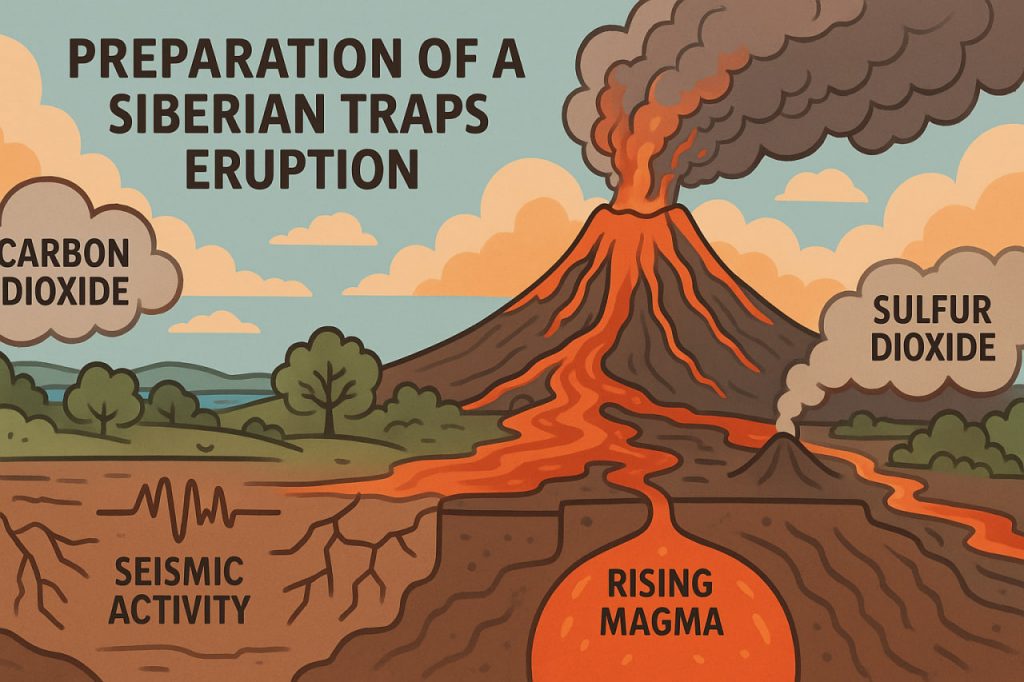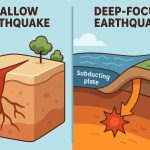The Siberian Traps are one of the largest large igneous provinces on Earth, located in present-day Siberia, Russia. They were formed about 252 million years ago during massive volcanic eruptions that lasted for hundreds of thousands of years. These eruptions released enormous amounts of lava, covering millions of square kilometers. Scientists link this event to the Permian–Triassic extinction, the largest mass extinction in Earth’s history. Understanding what could happen if such an eruption were to prepare again helps us evaluate both local and global consequences.
Early Signs of Preparation
If a new Siberian Traps eruption were preparing, the first signs would likely come from seismic activity deep below the crust. Rising magma would cause swarms of earthquakes as it forced its way upward. Ground deformation, such as swelling or fracturing of the surface, could also occur. In addition, gas emissions, particularly carbon dioxide and sulfur dioxide, would increase around volcanic vents. These signals could be detected by satellites and monitoring stations, providing early warnings of potential danger.
Release of Greenhouse Gases
One of the most devastating aspects of a Siberian Traps-style eruption is the massive release of greenhouse gases. Volcanic carbon dioxide would significantly increase global temperatures, while methane trapped in permafrost could be released as well, amplifying the effect. This greenhouse warming would destabilize ecosystems, melt glaciers, and disrupt climate systems worldwide. Scientists estimate that during the ancient eruption, these gases triggered a rapid global warming event that lasted millions of years. Such changes would unfold much faster in modern times due to existing climate stress.
Ash and Aerosols in the Atmosphere
Alongside greenhouse gases, the eruption would release vast amounts of sulfur aerosols and volcanic ash. These particles can block sunlight, leading to a temporary volcanic winter with reduced global temperatures. Crops would fail, ecosystems would struggle, and food shortages could follow. This contrast—short-term cooling from aerosols and long-term warming from carbon dioxide—would create unpredictable climate fluctuations. The combination of extreme heat and short cooling periods would put immense stress on both natural and human systems.
Impact on Ecosystems and Life
The preparation for a Siberian Traps eruption would already affect ecosystems before full-scale lava flows occurred. Acid rain from sulfur emissions would damage vegetation and pollute water sources. Marine ecosystems would suffer from ocean acidification as excess carbon dioxide dissolved in seawater. Many species would face extinction risks as habitats became uninhabitable. If history repeated itself, biodiversity loss on a massive scale could occur, similar to what happened 252 million years ago.
Global Consequences for Humanity
In modern times, a Siberian Traps eruption would not only be a geological disaster but also a global crisis. Disruption of agriculture, collapse of supply chains, and mass migrations could occur. Air traffic would be halted by ash clouds, and respiratory illnesses would increase due to poor air quality. International cooperation would be necessary to manage food distribution and disaster response. Economically and socially, such an event would be more disruptive than any known natural catastrophe in recorded history.
Conclusion
The preparation for a Siberian Traps eruption would involve deep seismic activity, rising magma, and vast releases of gases long before lava flooded the surface. These processes would destabilize the climate, ecosystems, and human societies. Awareness of these processes also highlights the importance of monitoring and global preparedness for large-scale volcanic threats.
Glossary
- Siberian Traps – a vast volcanic region in Siberia formed during massive eruptions 252 million years ago.
- Large igneous province – an area of extensive volcanic rock formed by enormous eruptions.
- Magma – molten rock beneath the Earth’s surface.
- Carbon dioxide (CO₂) – a greenhouse gas that contributes to global warming.
- Sulfur dioxide (SO₂) – a volcanic gas that can cause acid rain and cooling effects.
- Volcanic winter – temporary global cooling caused by volcanic aerosols blocking sunlight.
- Ocean acidification – the process of oceans becoming more acidic due to excess CO₂ absorption.


